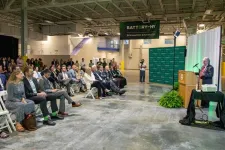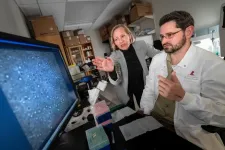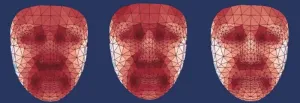(Press-News.org) BINGHAMTON, N.Y. -- National Science Foundation (NSF) officials joined Binghamton University, State University of New York to officially launch the Upstate New York Energy Storage Engine. After winning the designation earlier this year, Binghamton University and its New Energy New York and Engine coalition partners gathered to celebrate what this all means to the region.
At a press conference on Thursday, Binghamton University President Harvey Stenger welcomed NSF Assistant Director of the Technology, Innovation and Partnerships (TIP) Directorate Erwin Gianchandani to Binghamton to help launch the Engine program.
Erwin told the crowd that Sethuraman Panchanathan, director of the NSF, is pleased with the progress demonstrated to date by the Upstate Engine.
“We’re thrilled to see the impact and progress from the New York NSF Engine,” Panchanathan said. “In just a few short months, with the support of NSF and the U.S. Economic Development Administration, this team has already been building serious momentum by creating new industry partnerships and laying the groundwork to build new battery development facilities to accelerate energy and battery supply chain innovations while driving technology innovation, U.S. competitiveness and local workforce development.”
The press conference was held at the former Gannett warehouse facility in Johnson City. President Stenger announced that the building, which is owned by the University’s Foundation, will be the future home of Battery NY.
A first-of-its-kind research and development center supporting industries looking to create advanced, sustainable battery technologies, Battery NY was announced when the University won the federal Economic Development Administration’s Build Back Better Regional Challenge (BBBRC) program and was originally planned for a different site. But the Johnson City building is providing a central location, closer to the University, with more room to build and also the potential for expansion in the future.
“This is an exciting step in our vision for creating a full-scale, lab-to-market battery economy right here in upstate New York,” Stenger said. “Through NENY and its partnerships with federal agencies, other colleges and universities, and industry-leading companies and startups, we’re striving to be global innovators in batteries and energy storage.”
NENY builds on the research of Distinguished Professor M. Stanley Whittingham, who received the Nobel Prize in Chemistry in 2019 for his work in the development of lithium-ion batteries, a key component of renewable energy storage as the world weans itself from fossil fuels.
“This funding will let us come up with new inventions, which we intend to test out and build up to a commercial stage in this facility,” said Whittingham, who last week was named a knight bachelor of the United Kingdom as part of King Charles III’s birthday honors list.
Founded two years ago, NENY has attracted academic and corporate partners that have developed a host of programs to support the growth of the battery and energy storage manufacturing industry.
The NSF designation joins the $63.7 million awarded through the BBBRC in September 2022 and the designation as a federal Battery Tech Hub in October 2023. Binghamton is the only U.S. university to receive all three designations. New York’s Empire State Development is also supporting all of the NENY initiatives with more than $60 million in state investments.
U.S. Senate Majority Leader Chuck Schumer said in a statement that he had Binghamton and other Southern Tier and upstate communities in mind when he wrote and passed the federal CHIPS and Science Law in 2022 that created the NSF Regional Innovation Engines Competition.
“I believed so strongly that if we could make smart federal investments boosting the great innovations happening across this country, we could combat some of the biggest threats we face to our economic preeminence and future vitality and growth, protect supply chains, and boost domestic industries — all while bringing new opportunities and jobs back to communities like those right here in upstate New York,” wrote Schumer.
“That is why I have been New Energy New York’s biggest champion since day one, and I am so proud of this team and all their accomplishments.”
Ben Verschueren, executive director of Empire State Development’s Division of Science, Technology and Innovation (NYSTAR), sees the coalition of state and federal funding for NENY as “exponential drivers for positioning New York and the U.S. as a global leader in energy storage.”
“This region has an immense amount of talent and can take on a challenge like this,” Verschueren added. “We’re so excited to see a vibrant and expansive consortium of partners committed to executing a grand vision for the future.”
A key research partner with NENY is Cornell University. Krystyn J. Van Vliet, vice president for research and innovation, is a materials engineer and appreciates the cooperation needed to innovate energy storage technology.
“Cornell University looks forward to continued and now amplified support of these efforts around innovation and technology translation that will advance upstate New York’s position as a national leader in battery technology,” Van Vliet said.
Serving as acting CEO of the Upstate NY Energy Storage Engine will be Meera Sampath, associate dean of research and graduate studies at Binghamton University’s Thomas J. Watson College of Engineering and Applied Science. She pointed to the accelerating effects of climate change for the urgent need to develop a greener energy economy.
“Batteries and storage technologies are foundational to a carbon-neutral economy and to meeting our New York energy goals,” Sampath said. “I am very honored to be part of the team that will drive innovation and inclusive growth in this crucial technology area.”
One of 10 inaugural NSF Regional Innovation Engines around the country, the Energy Storage Engine will receive $15 million from the NSF for the first two years of the project and up to $160 million over 10 years.
Federal and regional officials offer support for the Upstate New York Energy Storage Engine
Kelly Sanders, assistant director for energy systems innovation at the White House Office of Science, Technology and Policy: “President Biden has been steadfast in his commitment to Investing in All of America, spurring innovation and creating good-paying jobs in communities across the country. New Energy New York represents an effective and complementary investment between the state, NSF and EDA to recharge, restore and revitalize Binghamton and the Southern Tier of New York. This work — made possible by the president’s CHIPS and Science Act — is bolstering our nation’s security and long-term competitiveness in advanced batteries and energy storage.”
Empire State Development President, CEO and Commissioner Hope Knight: “The Southern Tier is quickly establishing itself as the place for next-generation battery industry innovation. New York state’s broad-based investments in this evolving industry, combined with the assistance of our federal partners at the National Science Foundation and Binghamton University, are fueling substantive, place-based research and development efforts, serving as a central driver for regional economic competitiveness, creating solid opportunities.”
State Sen. Lea Webb ‘04: “The groundbreaking work being done on the Upstate New York Energy Storage Engine, led by Binghamton University, is exemplary and integral in the continued economic vitality of our community. I am excited and proud to support its continued development. This project is a testament to the innovation and commitment of our researchers, students and other community stakeholders, as it positions the Southern Tier as a leader in the energy storage sector. The advancements being made here will drive economic growth, further community development and play a crucial role in addressing our state and nation’s energy challenges.”
Assemblywoman Donna Lupardo, MA ’83: “Today was the official kickoff of the NSF’s Upstate New York Energy Storage Engine. This Binghamton University-led initiative, along with their New Energy New York partners, will focus on energy storage, an ambitious plan to revolutionize the way that energy is stored. Years of dedication and hard work have gone into helping our area become a designated hub for battery innovation and manufacturing. While this Storage Engine will help New York address our climate goals, it also will lead the country toward a clean-energy future.”
Assemblymember Harry Bronson, chair of the Assembly Labor Committee: “NENY and Binghamton University will play a transformative role in shaping our region into a national hub for advanced battery manufacturing. With the investment from the National Science Foundation, multiple industry and academic partners, including RIT and over 27 regional counties, will work together on this program, demonstrating the collaborative, innovative ecosystem of the Upstate and Finger Lakes economy. Importantly, the NENY coalition also aligns with our goals to connect economic development to workforce development initiatives to ensure we are increasing equity and opportunity in our economy and creating the qualified workforce we need to bring New York into the future. Thank you, Sen. Schumer and the CHIPS and Science Act, for investing in our region.”
Ryne Raffaelle, vice president of research and associate provost at the Rochester Institute of Technology: “For more than a decade, RIT has been at the forefront of battery development. By expanding our partnerships in the NSF Innovation Engine with additional upstate New York organizations and universities, we expect a marked increase in R&D efforts that will provide both an innovative and economic impact for our state and across the nation.”
END
Binghamton University marks official launch of federally funded battery initiative
Battery NY to be located in University-owned facility in Johnson City
2024-07-02
ELSE PRESS RELEASES FROM THIS DATE:
Women of color disproportionately targeted by book bans, study finds
2024-07-02
In 2023, the American Library Association documented hundreds of attempts to remove more than 4,000 books from schools and libraries across nearly all states in the U.S.
In one of the first comprehensive analyses of book bans in the U.S., a University of Colorado Boulder researcher and her collaborators revealed that these bans disproportionally target women authors of color, and a large portion of the banned books feature characters of color.
The findings appeared June 11 in the journal ...
The American Society for Nutrition announces Orlando, Florida as the location for its annual flagship meeting, NUTRITION 2025
2024-07-02
The American Society for Nutrition (ASN) has announced that next year’s meeting is scheduled to be held May 31 – June 3, 2025, in Orlando, Florida. NUTRITION is the premier meeting for the nutrition community, exploring developments in clinical and translational nutrition, food science and systems, diet and disease, basic science, global health and more. In its seventh year, the event has continued to evolve and grow with innovative scientific sessions and networking opportunities for scientists, clinicians and healthcare professionals interested in ...
Serendipity reveals new method to fight cancer with T cells
2024-07-02
MADISON — A promising therapy that treats blood cancers by harnessing the power of the immune system to target and destroy cancer cells could now treat solid tumors more efficiently. Thanks to a recent study published in Molecular Therapy – Methods & Clinical Development from Dan Cappabianca and Krishanu Saha at the Wisconsin Institute for Discovery, Chimeric Antigen Receptor (CAR) T-cell therapy can be improved by altering the conditions the T cells are grown in. And it was all discovered by chance.
...
Financial incentives double smoking cessation rate for people with socioeconomic challenges
2024-07-02
OKLAHOMA CITY, OKLA. – A study published today by a University of Oklahoma researcher shows that financial incentives can make a big difference in helping smokers quit. The study found that when people with low socioeconomic staus are offered small financial incentives to stop smoking (in addition to receiving counseling and pharmacotherapy, primarily nicotine replacement therapy), they achieve higher quit rates, with some measures doubling the quit rates, when compared to study participants who received the same treatments without incentives. This finding is particularly important because adults with socioeconomic challanges ...
Biomolecular condensate ‘molecular putty’ properties found encoded in protein sequence
2024-07-02
(MEMPHIS, Tenn. – July 2, 2024) Biomolecular condensates are membraneless hubs of condensed proteins and nucleic acids within cells, which researchers are realizing are tied to an increasing number of cellular processes and diseases. Studies of biomolecular condensate formation have uncovered layers of complexity, including their ability to behave like a viscoelastic material. However, the molecular basis for this putty-like property was unknown. Through a multi-institution collaboration, St. Jude Children’s Research Hospital scientists examined the interaction networks within condensates ...
New MSU study finds systematic biases at play in clinical trials
2024-07-02
MSU has a satellite uplink/LTN TV studio and Comrex line for radio interviews upon request.
EAST LANSING, Mich. – Randomized controlled trials, or RCTs, are believed to be the best way to study the safety and efficacy of new treatments in clinical research. However, a recent study from Michigan State University found that people of color and white women are significantly underrepresented in RCTs due to systematic biases.
The study, published in the Journal of Ethnicity in Substance Abuse, reviewed 18 RCTs conducted over the last 15 years that tested treatments for post-traumatic stress and alcohol use disorder. The researchers ...
Nuclear spectroscopy breakthrough could rewrite the fundamental constants of nature
2024-07-02
Key takeaways
Raising the energy state of an atom’s nucleus using a laser, or exciting it, would enable development of the most accurate atomic clocks ever to exist. This has been hard to do because electrons, which surround the nucleus, react easily with light, increasing the amount of light needed to reach the nucleus.
By causing the electrons to bond with fluorine in a transparent crystal, UCLA physicists have finally succeeded in exciting the neutrons in a thorium atom’s nucleus using a moderate amount of laser light.
This accomplishment means that measurements of time, gravity and other fields that are currently performed ...
Groundbreaking University of Alberta study discovers connection between between heart and brain in KBG syndrome
2024-07-02
EDMONTON — A new groundbreaking study sheds light on a medical question scientists have long wondered: why do 40 per cent of children with the rare neurodevelopmental disorder KBG syndrome have heart defects? The research now points to a critical link between the heart and the brain.
KBG syndrome can cause unusual facial development, skeletal abnormalities, intellectual underdevelopment and heart defects. The syndrome is caused by mutations in the ANKRD11 gene, which plays a crucial role in brain development, but it wasn’t until now ...
Optoelectronics gain spin control from chiral perovskites and III-V semiconductors
2024-07-02
A research effort led by scientists at the U.S. Department of Energy’s (DOE’s) National Renewable Energy Laboratory (NREL) has made advances that could enable a broader range of currently unimagined optoelectronic devices.
The researchers, whose previous innovation included incorporating a perovskite layer that allowed the creation of a new type of polarized light-emitting diode (LED) that emits spin-controlled photons at room temperature without the use of magnetic fields or ferromagnetic contacts, now have gone a step further by integrating a III-V semiconductor ...
Doctors could soon use facial temperature for early diagnosis of metabolic diseases
2024-07-02
A colder nose and warmer cheeks may be a telltale sign of rising blood pressure.
Researchers discovered that temperatures in different face regions are associated with various chronic illnesses, such as diabetes and high blood pressure. These temperature differences are not easily perceptible by one’s own touch but can instead be identified using specific AI-derived spatial temperature patterns that require a thermal camera and a data-trained model. The results appear July 2 in the journal Cell Metabolism. With ...
LAST 30 PRESS RELEASES:
Next-generation vision model maps tree growth at sub-meter precision
Genes aren’t destiny for inherited blindness, study shows
MIT study: High-fat diets make liver cells more likely to become cancerous
Exposure to multiple fine particulate matter components and incident depression in the US Medicare population
Risk of burdensome health care spending over time in the US
Nirsevimab against hospitalizations and emergency department visits for lower respiratory tract infection in infants
New microfluidics technology enables highly uniform DNA condensate formation
A new strategy for immune tolerance
Super Mario Bros. help fight burnout: New study links classic games to boosted happiness
Deepest gas hydrate cold seep ever discovered in the arctic: International research team unveils Freya Hydrate Mounds at 3,640 m depth.
Integrating light and structure: Smarter mapping for fragile wetland ecosystems
ACA-SIM: A robust way to decode satellite signals over complex waters
Probiotics can restore gut microbiome in breastfed infants
AI could help predict nutrition risks in ICU patients, study finds
Federal EITC has unexpected result, researchers say – it decreases domestic violence
Researchers identify gene that calms the mind and improves attention in mice
Artificial metabolism turns waste CO2 into useful chemicals
Ancient sea anemone sheds light on animal cell type evolution
Begging gene leads to drone food
How climate policies that incentivize and penalize can drive the clean energy transition
Can community awareness campaigns in low-resource areas improve early diagnosis of colorectal cancer?
Stardust study resets how life’s atoms spread through space
Practical education: Clinical scenario-based program development
The impact of family dynamics on eating behaviour – how going home for Christmas can change how you eat
Tracing the quick synthesis of an industrially important catalyst
New software sheds light on cancer’s hidden genetic networks
UT Health San Antonio awarded $3 million in CPRIT grants to bolster cancer research and prevention efforts in South Texas
Third symposium spotlights global challenge of new contaminants in China’s fight against pollution
From straw to soil harmony: International team reveals how biochar supercharges carbon-smart farming
Myeloma: How AI is redrawing the map of cancer care
[Press-News.org] Binghamton University marks official launch of federally funded battery initiativeBattery NY to be located in University-owned facility in Johnson City



